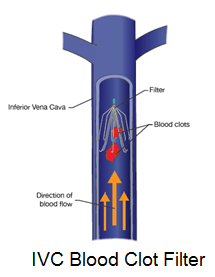 (July 16, 2018) A new study questions the use of IVC filters in DVT patients undergoing CDT, catheter-directed thrombosis. The study led by Temple University showed no in-hospital mortality benefit, and worse. It showed IVC filters associated with increased procedure-related hematomas, and it also showed that using IVC filters led to lengthier hospital stays and higher bills.
(July 16, 2018) A new study questions the use of IVC filters in DVT patients undergoing CDT, catheter-directed thrombosis. The study led by Temple University showed no in-hospital mortality benefit, and worse. It showed IVC filters associated with increased procedure-related hematomas, and it also showed that using IVC filters led to lengthier hospital stays and higher bills.
Related: Cook Medical loses $1.2 Million Verdict
IVC filters are alleged by their makers to help treat DVT, deep-vein thrombosis. They are advertised – by Cook Medical, C.R. Bard, and other IVCF makers – to be indispensable, life-saving devices. But their effectiveness in every regard has been questioned by thousand of IVC filter lawsuits.
DVT occurs when blood clots develop in the deep veins of the legs, thigh, or pelvis. These clots can break loose, travel to the lungs, and cause life-threatening pulmonary embolism (PE). Proximal DVT – a clot in the thigh or pelvis – has been linked with a higher risk for post-thrombotic syndrome.
Post Thrombotic Syndrome (PTS) and Catheter-Directed Thrombosis (CDT)
PTS is a painful condition characterized by swelling, redness, and leg sores. In hopes of reducing the high incidence of PTS in patients treated solely with a blood thinner, many doctors today use catheter-directed thrombolysis. CDT is a minimally invasive procedure in which an infusion catheter delivers clot-busting drugs directly into the clot. Fluoroscopically guided, CDT can potentially reestablish blood flow through a newly-blocked vein.
In hopes of preventing clots from breaking loose and migrating to the lungs during a CDT procedure, some doctors choose to simultaneously implant an inferior vena cava filter (IVCF). IVCFs are wire-basket-like devices inserted into the inferior vena cava, a large vein that returns blood from the lower body to the heart and lungs. IVCFs are used on the theory that they capture blood clots which would otherwise reach the lungs. There is some evidence, which has been produced by IVC filter makers, to support the IVCF theory; but it is scant, at best, and far from convincing, which has led to IVC filter lawsuits.
Any IVC Filter Benefit is Unclear
A research team led by Riyaz Bashir, MD, FACC, RVT, Professor of Medicine at the Lewis Katz School of Medicine at Temple University (LKSOM), and Director of Vascular and Endovascular Medicine at Temple University Hospital (TUH), sought to address the question of whether there is any benefit of IVCF placement at the time of CDT. The team began by examining nationwide utilization rates of IVCFs in patients undergoing CDT. They wanted to assess contemporary trends and compare outcomes with patients who do not undergo IVCF placement. The team’s findings were published online July 16, 2018 and also in the July 23rd issue of the journal JACC: Cardiovascular Interventions.
Limited Data for IVCF Patients – 7 Years
“Limited data exists on the effectiveness of IVCF use in patients undergoing CDT for the treatment of proximal DVT,” said Dr. Bashir. “This study is noteworthy because it is the first to evaluate national trends and comparative outcomes related to this practice.”
The research team used the National Inpatient Sample database to identify every person in the U.S. with DVT who underwent CDT (with and without IVCF placement) from January 2005 to December 2013.
The team’s findings include these conclusions:
- IVCF used in patients undergoing CDT for DVT was not associated with any significant in-hospital mortality decrease compared to patients who did not receive an IVCF.
- IVCF used in patients undergoing CDT for DVT was associated with an increase in procedure-related hematoma formation (3.4% vs. 2.1%), in-hospital costs ($104,049 vs. $92,881) and length of stay (7.3 days vs. 6.9 days) compared to patients who did not receive an IVCF.
Dr. Bashir said that based on these results, his team believes, “IVCFs should not be routinely placed in patients undergoing CDT.” Dr. Bashir also called for more well-designed, randomized control trials “to elucidate the implications of IVCF placement in patients undergoing CDT.”
Related
- IVC Filter Lawsuit | Lawyer
- Cook Medical loses $1.2 Million IVC Filter Verdict
- IVC Filter Verdict: $4 Million
- IVC Filter Controversy Rages
- Medical Devices Wild West for Safety Problems, Profits

by Matthews & Associates




